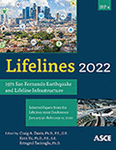Risk Management System for Road Networks Exposed to Natural Hazards
Publication: Lifelines 2022
ABSTRACT
Road networks aim to provide mobility and accessibility to population, goods, and services. To promote and ensure this major goal road networks must cover most diverse geographies and territories being frequently affected by natural hazards. The effects of natural events directly affect the role of providing access in remote areas as well as ensuring an efficient mobility in major highways. Available risk management systems generally study the physical effects of natural hazards over road infrastructure centering efforts in the vulnerability of network components and the consequent economic losses due to certain levels of damage. Limited literature is available regarding the operational consequences over network mobility and accessibility and the socio-economic consequences to users and non-users. This article proposes an integrated management system that accounts for network risk in terms of travel time delays, the optimization of mitigation strategies to reduce risk, and the effects of considering other dimensions in decision-making such as social vulnerability and accessibility to critical infrastructure. The system considers the effects and consequences of seismic, flooding, and volcanic hazards. The models accounted by the management system consider hazard modeling and characterization, fragility of road infrastructure (pavement structures, tunnels, bridges, and cut slopes), social vulnerability of exposed population, network risk estimated in terms of travel time delays, and the optimization of mitigation strategies. The optimization process in addition considers a greedy randomized adaptive search procedure algorithm, funding allocation with budgetary restrictions, and network topological analysis. The proposed management system is applied to a road network exposed to seismic hazard in Central Chile. The system is intended to assist road authorities in the assessment of network risk and the development of effective mitigation strategies to increase road network resilience to natural hazards.
Get full access to this article
View all available purchase options and get full access to this chapter.
REFERENCES
Baker, J. W. (2008). An Introduction to Probabilistic Seismic Hazard Analysis (PHA). Proceeding of the Natonal Academy of Sciences. https://doi.org/10.1073/pnas.1525665113.
Basöz, N., and Mander, J. (1999). Enhancement of the high- way transportation lifeline module in HAZUS. Washington, D.C.: National Institute of Building Sciences.
Beckmann, M., McGuire, C., and Winsten, C. (1956). Studies in the economics of transportation. New Haven, CT: Yale University Press.
Chamorro, A., Echaveguren, T., Allen, E., Contreras, M., Dagá, J., de Solminihac, H., and Lara, L. E. (2020). Sus- tainable risk management of rural road networks exposed to natural hazards: Application to volcanic lahars in chile. Sustainability, 12(17), 6774.
Cutter, S. L. (1996). Vulnerability to environmental hazards. Prog Hum Geogr 20(4):529–539.
Cutter, S. L., Emrich, C. T., Morath, D. P., and Dunning, C. M. (2013). Integrating social vulnerability into federal flood risk management planning, Journal of Flood Risk Management, 6, 332–344, https://doi.org/10.1111/jfr3.12018.
Free, M., Anderson, S., Milloy, C., and Mian, J. (2006). Geohazards risk management for infrastructure projects. Proceedings of the ICE – Civil Engineering, 159, 28–34.
G&E. (1994). NIBS earthquake estimation methods technical manual. G&E Engineering System.
Jayaram, N., and Baker, J. W. (2010). Efficient sampling and data reduction techniques for probabilistic seismic lifeline risk assessment. Earthquake Engineering & Structural Dynamics, 39(10), 1109–1131.
Joyner, W. B., and Boore, D. M. (1988, June). Measurement, characterization, and prediction of strong ground motion. In Earthquake engineering and soil dynamics ii, proceed- ings of american society of civil engineers geotechnical engineering division specialty conference (pp. 43–102). Park City, Utah.
Koks, E. E., Jongman, B., Husby, T. G., and Botzen, W. J. W. (2015). Combining hazard, exposure and social vulnerability to provide lessons for flood risk management. Environmental Science & Policy, 47, 42-52. https://doi.org/10.1016/j.envsci.2014.10.013.
Montalva, G., Bastias, N., and Rodriguez-Marek, A. (2017). Ground‐Motion Prediction Equation for the Chilean Subduction Zone. Bulletin of the Seismological Society of America. 107. https://doi.org/10.1785/0120160221.
Mostafaei, H. (2013). Handbook of Seismic Risk Analysis and Management of Civil Infrastructure Systems. Handbook of Seismic Risk Analysis and Management of Civil Infrastructure Systems. https://doi.org/10.1533/9780857098986.3.366.
NIBS (National Institute of Building Sciences). (2004). HAZUS-MH: user’s manual and technical man- uals. Washington, DC: National Institute of Building Sciences.
Poulos, A., Monsalve, M., Zamora, N., and de la Llera, J. C. (2019). An updated recurrence model for chilean sub- duction seismicity and statistical validation of its poisson nature. Bulletin of the Seismological Society of America, 109(1), 66–74.
Schneider, P. J., and Schauer, B. (2006). HAZUS—Its Development and Its Future. Natural Hazards Review. 7(2):40–44.
Schmidt, J., Matchman, I., Reese, S., King, A., Bell, R., Henderson, R., Smart, G., Cousins, J., Smith, W., and Heron, D. (2011). Quantitative multi-risk analysis for natural hazards: a framework for multi-risk modeling. Natural Hazards. 58:1169-1192.
Information & Authors
Information
Published In
History
Published online: Nov 16, 2022
Authors
Metrics & Citations
Metrics
Citations
Download citation
If you have the appropriate software installed, you can download article citation data to the citation manager of your choice. Simply select your manager software from the list below and click Download.
